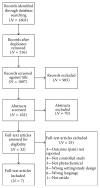Systematic Review of the Use of Phytochemicals for Management of Pain in Cancer Therapy
- PMID: 26576425
- PMCID: PMC4630373
- DOI: 10.1155/2015/506327
Systematic Review of the Use of Phytochemicals for Management of Pain in Cancer Therapy
Abstract
Pain in cancer therapy is a common condition and there is a need for new options in therapeutic management. While phytochemicals have been proposed as one pain management solution, knowledge of their utility is limited. The objective of this study was to perform a systematic review of the biomedical literature for the use of phytochemicals for management of cancer therapy pain in human subjects. Of an initial database search of 1,603 abstracts, 32 full-text articles were eligible for further assessment. Only 7 of these articles met all inclusion criteria for this systematic review. The average relative risk of phytochemical versus control was 1.03 [95% CI 0.59 to 2.06]. In other words (although not statistically significant), patients treated with phytochemicals were slightly more likely than patients treated with control to obtain successful management of pain in cancer therapy. We identified a lack of quality research literature on this subject and thus were unable to demonstrate a clear therapeutic benefit for either general or specific use of phytochemicals in the management of cancer pain. This lack of data is especially apparent for psychotropic phytochemicals, such as the Cannabis plant (marijuana). Additional implications of our findings are also explored.
Figures



References
-
- Fawole O. A., Amoo S. O., Ndhlala A. R., Light M. E., Finnie J. F., Van Staden J. Anti-inflammatory, anticholinesterase, antioxidant and phytochemical properties of medicinal plants used for pain-related ailments in South Africa. Journal of Ethnopharmacology. 2010;127(2):235–241. doi: 10.1016/j.jep.2009.11.015. - DOI - PubMed
Publication types
MeSH terms
Substances
Grants and funding
LinkOut - more resources
Full Text Sources
Other Literature Sources
Medical
Miscellaneous

